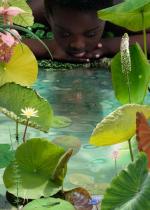The fantastic world of Ruud van Empel
RvE: As always, there are so many, my whole life i have been looking at art and this builds up your own personal databank, deep in your brain all these images are somehow preserved and out of that a certain taste for art results i guess.
Artist that were important to me are: Otto Dix, Mike Disfarmer, Norbert Ghisoland, Lucas Cranach, Georges Melies, Walter Spies, Edvard Munch, Federico Fellini, Saul Steinberg, Cindy Sherman e Tadanori Yokoo
FB: A lot of contemporary art is purely conceptual and gestural. The formal aspect, if it matter, is often antiaesthetic. Your photographies, as well as being innovative, surreal, mysterious, as well as they establish a dialogue with the audience, are also quite beautiful. Can you talk about the importance of aesthetics in your job? Do you believe that the time has come to rediscover beauty? Do you ever get a critique of your images because they are “too beautiful”?
RvE: What is crazy about this question is the fact that beauty has been a taboo in modern art for such a long time, it was seen as weak to make beautiful pictures, but in fact it is very difficult to create real beauty.
When I choose the subject of innocence i wanted to show it’s beauty, innocence is beauty, and that is important to understand and not to forget.
So that is one of the important reasons that my images are beautiful, because of this subject.
Another reason is that I am tired of cynical and ironical images, or just ugly images that are strange and not understandable, we have seen so much of that in contemporary art the last 30 to 40 years,
I feel I needed to do something different.
FB: Yes, I absolutely agree on this principle, it is time to see something new.
But let’s go back a moment to your way of working.To obtain images combining various heterogeneous elements, requires a lot work and is really time consuming. In art, especially contemporary art, the complexity of the technique does not really matter. But photography always was concerned with difficulties of implementation and technical complexity. Images obtained through long and difficult process often seem to have an added value. Long manipulation obtained in the darkroom were exposed with pride. Today when in a few seconds you can achieve the same result with a Photoshop filter, nobody thinks to those prints as works of art. In your case, are you interested only in the final result, and run through the collage work is the only possible way to get it? Or in the process of collage do you find your personal aesthetic, an intrinsic motivation?
To read the rest of this article go to page: 1 2 3 4 5






Massimo Cristaldi
said, December 1, 2007 @ 12:12 PM :
Complimenti per l’Intervista. Bravo l’autore ed interessanti gli scatti.
Ed ancora più interessante, se mi consenti, il tuo tentativo di fare, in lingua italiana quanto JM Colber, ad esempio, fa su Conscentious.
Bravo F!
Fabiano Busdraghi
said, December 1, 2007 @ 3:28 PM :
Ciao Massimo e grazie per la visita.
Il paragone con Conscientious di Colberg è molto lusinghiero. Rispetto a lui però preferisco scrivere meno, ma approfondire di più ogni articolo. Questa è una delle principali linee guida di CameraObscura. Articoli lunghi, completi e approfonditi.
Sto cercando di trovare una soluzione efficace per scrivere in diverse lingue, e pubblicare così anche la versione originale delle interviste, ma per il momento ho dei problemi tecnici che non riesco a sormontare.
Ciao ciao e ancora grazie
merendello
said, December 2, 2007 @ 7:29 PM :
Ciao Fab,
come vedi son finalmente entrato in CameraObscura.
Complimenti per l’intervista: domande intelligenti, impaginazione ottima (odio quando una foto di cui si parla nel testo te la devi andare a cercare).
Apprezzo molto questo tuo modo di far conoscere la fotografia contemporanea.
ciao ciao,
mm
Massimo Cristaldi
said, December 3, 2007 @ 9:28 AM :
Ciao Fabiano,
mi sembra che utilizzi wordpress, giusto? Dai un occhio al plugin “polyglot” che dovrebbe rispondere alla tue esigenze.
Massimo
Fabiano Busdraghi
said, December 3, 2007 @ 10:01 AM :
Grazie massimo del consiglio.
Polyglot è un plugin carino, ma purtroppo, come altri plugins simili tipo Babel, è pensato più per la traduzione di un unico post, e non di un sito intero. Non supporta i tag multilingua, non permette di filtrare il post per ottenere un pdf solo nella lingua corrente, e soprattutto non nasconde i post che non hanno traduzione.
Quest’ultima è la cosa più difficile da ottenere. In pratica, la maggior parte dei plugins multilingua sono efficaci se traduci quasi ogni post in tutte le lingue. Se manca la traduzione di un post stampano qualcosa del tipo “nessuna traduzione per questo post”. CameraObscura sarà principalmente in Italiano e solo occasionalmente in altre lingue. Sarebbe quindi opportuno che il loop wp mostri unicamente i post della lingua corrente.
L’unico plugin che si comporta in questo modo a mio sapere è Gengo. Purtroppo però lo sviluppo è fermo da alcuni mesi, la versione 2.2 è solo parzialmente supportata e non è compatibile con wp 2.3. Visto che questo plugin modifica pesantemente wp ho paura di avere infiniti problemi con gli upgrade successivi di wp. Inoltre solito problema con i pdf e i tag.
Il plugins migliore in assoluto che ho trovato per il momento è Language Switcher. Supporto tag multilingua, filtro dell’output degli altri plugins, documentazione eccellente, aggiornatissimo, etc. Però solito problema che mostra tutti i post.
Un’altra soluzione sarebbe quella di fare un blog indipendente per ogni lingua. Uno quello che è CameraObscura adesso, un’altro per esempio en.cameraobscura.busdraghi.net e via dicendo. È molto facile in questo modo ottenere tutto quello che desidero, l’unico problema è che quando si cambia lingua riesco a trovare si finisce sempre nella homepage dell’altra lingua, non mi viene in mente nessun modo semplice per mostrare se sono disponibili traduzioni del post corrente.
A tuo avviso, è un problema? O sarebbe preferibile avere una lista di post con “nessuna traduzione disponibile” e di tanto in tanto un post tradotto come fa language switcher?
ciao e grazie per il consiglio
f
gianluca
said, December 3, 2007 @ 6:05 PM :
Grazie per esser passato!!
..e continua così!.. un mare di informazioni utilissime
Massimo Cristaldi
said, December 4, 2007 @ 1:52 PM :
Fabiano,
sul mio blog personale ho adottato un approccio molto semplicistico: ho “taggato” con POST in italiano, quei posti che sono *SOLO* in italiano…. Non il massimo ma pratico. Certo, eliminino, su di essi, i lettori inglesi. Altrimenti l’unica alternativa è gestiere due blog in due lingue…. Ma è una fatica immane!
Massimo